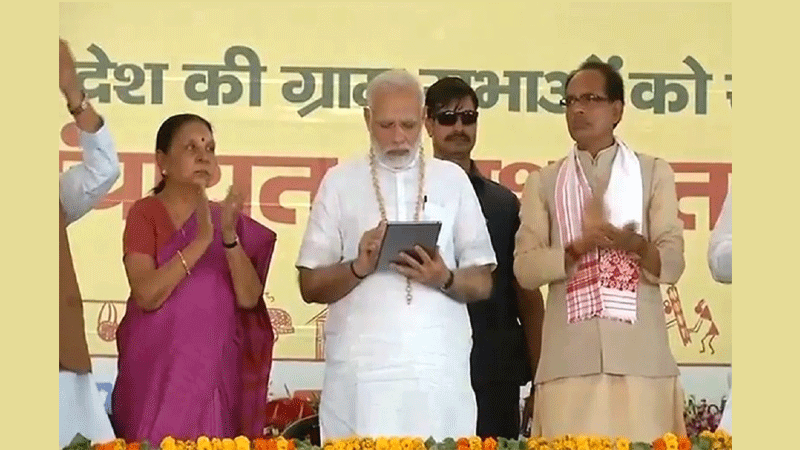Vikash Anand
Bharat” for Mahatma Gandhi was reflected in ‘village Swaraj’. He used to say the soul of Bharat resides in villages. When India got freedom, the Congress under the leadership of Pandit Jawaharlal Nehru started ruling India. Unlike Mahatma Gandhi, Pandit Nehru’s idea of India was neither village centric nor had village as a unit of development for the country. His concept of development for India was rather top to bottom. The lacuna in this idea gets reflected in the poor conditions of villages which resulted in widspred poverty in the country and poverty shocks amid the crisis. The idea of development conceived by Pandit Nehru and Indian National Congress later on, has left the country in cognitive dissonance, crushed moral judgements, entrenched economic discrimination and altered personal and social relationships thus leading to increased disparity in society.
When NDA came to power, under the leadership of Shri Narender Modi the idea of development reversed the thinking of economic growth & development from bottom to top.The focus was laid on formulating a village centric visionary policy that will help to create the foundation of a self-reliant village and progressive nation. Prime Minister Shri Modi in his first tenure launched Pradhan Mantri Jan-Dhan Yojana (PMJDY). It is the world’s largest national flagship programme for financial inclusion to ensure access to financial services, namely, Banking/ Savings & Deposit Accounts, Remittance, Credit, Insurance, Pension in an affordable manner to all poor. Account opened under PMJDY is opened with Zero balance. This provided poor, destitute, women and senior citizen with feeling of empowerment and participation in mainstream development discourse.
To put a check on the middlemen, who used to routinely siphon off large part of benefits meant for the poor and farmers, Modi Government executed policy of National Digital Policy and direct transfer of subsidies to farmers and other poor section of the society.This effort was appreciated world wide and reduced poverty substantially in India. Its effect is being witnessed in current situation of pandemic.
Prime Minister Shri Narendra Modi in his second tenure launched Pradhan Mantri Kisan Samman Nidhi (PM-KISAN).This scheme proved to be very beneficial during lockdown. Total of 9.67 crore farmers amid the lockdown got benefit of the PM-KISAN scheme by 28 May,2020. The Union Government has released more than 19 thousand crore rupees under the scheme in the last two months (March-April). The amount has been transferred directly to the farmers’ accounts through digital transfer thus ensuring regular consumption pattern and ensuring social security.In the scheme, the amount of Rs. 6000 per year has been paid to each eligible farmer in three installments and the amount will be transferred directly to their bank accounts.
The Agriculture sector has always been the priority of Govt. The government has also provided agricultural seeds to the farmers.Timely availability of fertilizers, agriculture inputs, procurement of food grains and strengthening cold storage facility has been done on across states.
The scheme is supplementary in nature which takes care of financial needs of Small and Marginal Farmers so that they can procure inputs that will ensure proper crop health and appropriate yields.The vision behind the PM-KISAN Scheme is to protect the farmers from trap of moneylenders for meeting their farming investment and ensuring their continuance in the farming activities.
PM Modi in his previous tenure brought the Agriculture Export Policy 2018 focusing to double farmers’ income by 2022. The Modi government new agriculture export policy has set the goal to double exports of agriculture products and to integrate Indian farmers and agricultural products with global value chains.To ensure doubling the agriculture export for making farmers stronger Modi government working on key measures like Infrastructure and logistics support, comprehensive approach to boost exports,greater involvement of state government in agriculture exports,promoting value-added exports, marketing and promotion of Brand India. And the government has formulated policy to attract private investments into production & processing.
In 2016 the government launched online National Agriculture Marketing Platform called e-NAM. The platform facilitates farmers,traders and buyers for trading of agriculture products.
The e-NAM is helping in finding better price.The e-NAM markets are getting popular as the crops are weighed immediately and the stock is lifted on the same day and the payments are cleared online. The platform obliterates all type hurdle whether be it bureaucratic or unwanted interference of middleman. Shri Narendra Modi launched this platform aims making self-reliant villages on 14 April 2016.
Apart from above mentioned major initiatives of Modi Government, for making farmers financially secure in the case of poor crop growth, it launched Pradhan Mantri Fasal BimaYojna.To provide irrigation facilities to farmers across the country, it launched Pradhan Mantri Krishi Sinchai Yojana (PMKSY) and propelled money into the National Bank for Agriculture and Rural Development to boost credit penetration to farmers.
The Modi led BJP government also focused on electrification of every village of the country. Modi Government in its previous term has provided electric connection to every village. For this great achievement, the global energy watchdog International Energy Agency(IEA) in 2018 called India a ‘star performer’ in terms of achieving the big milestone of the providing power to each village.The institution praised Modi Government for taking electricity to every village.
With IMF and World Bank reducing the World’s GDP, India has been kept on Higher growth rate compared to many developed nations. The govt has given agriculture sector special focus in this period of crisis so that 57% of the total population engaged in this field don’t suffer. With clear framework and determination, the Govt will revive the economy of the country.
(The writer is Associate Editor, Kamal Sandesh)


